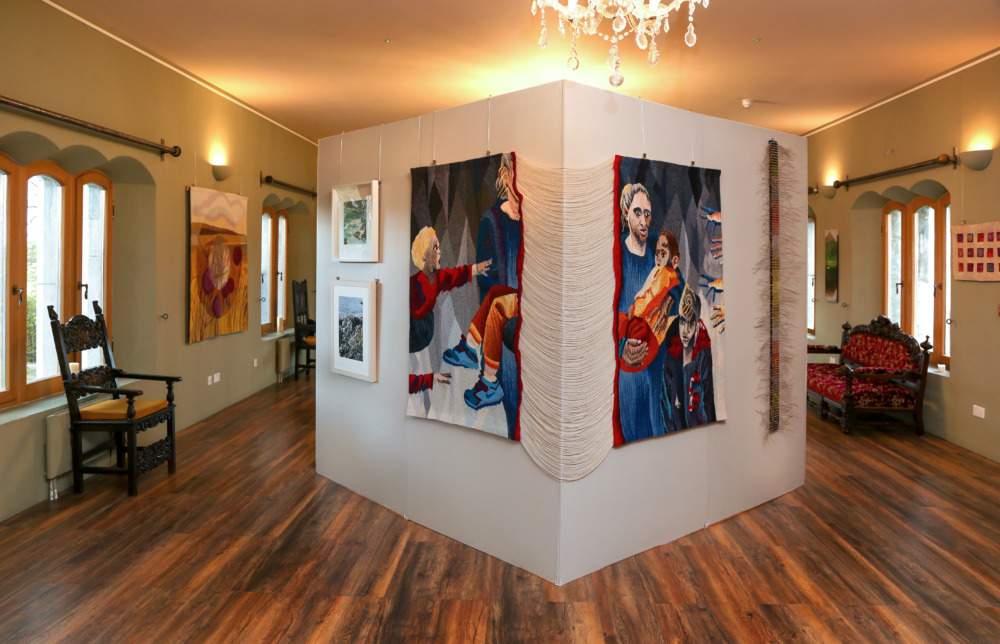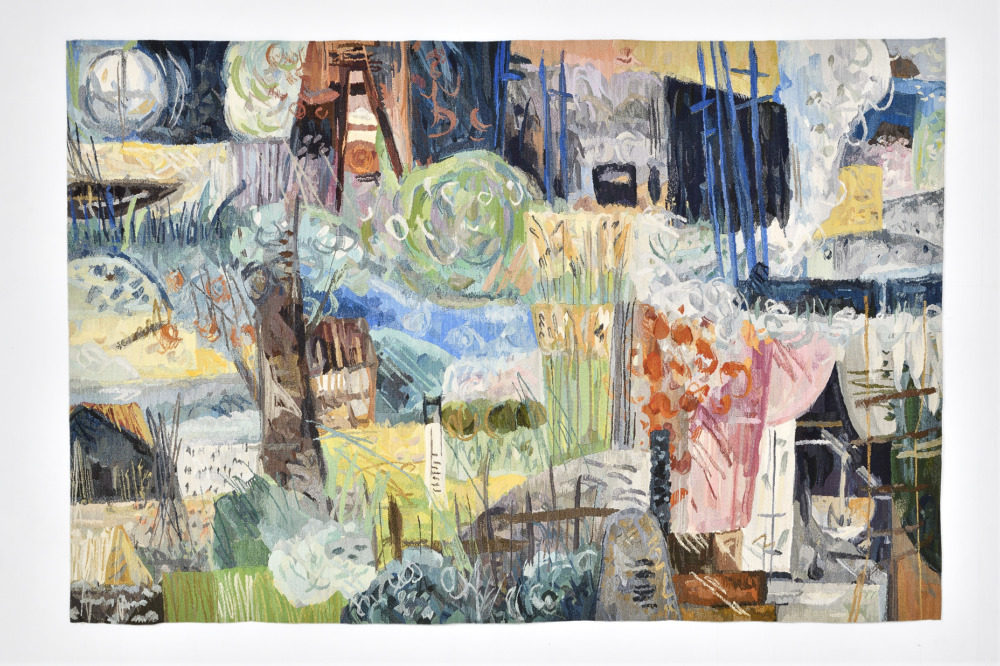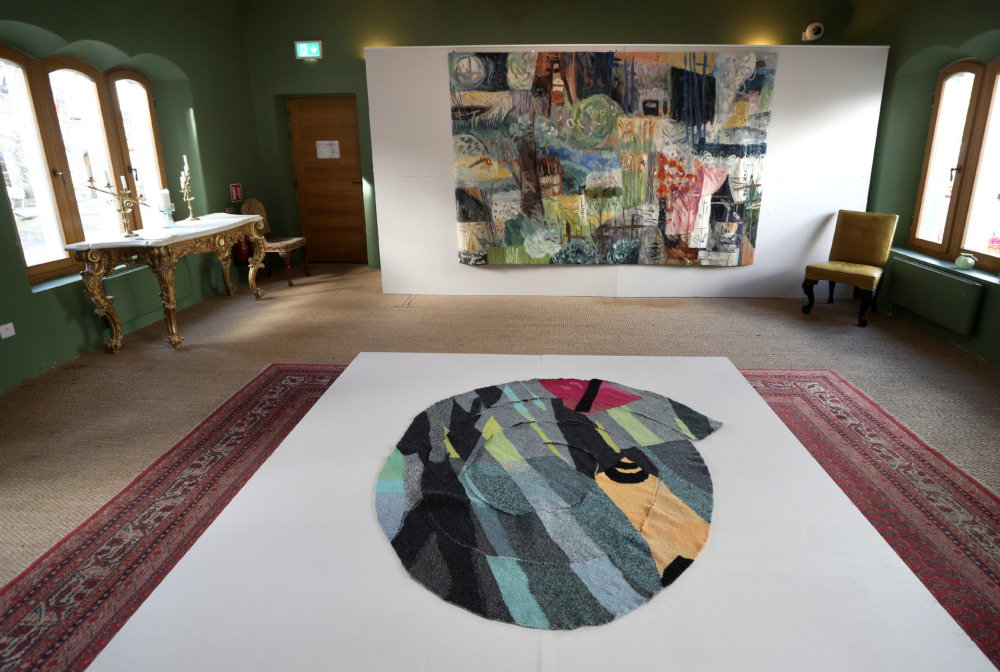Column
ColumnWorlds apart, contemporary artists weave the story of tapestry as a fine art
The tradition of tapestry making is thousands of years old and it is constantly evolving. Contemporary tapestry weavers continue to explore and re-define the process of tapestry, using new materials and forms. Choosing to display tapestry to highlight this distinctive wool tradition in fine art was part of the Galway 2020 PROJECT BAA BAA celebration of Sheep Farming and Associated Traditions Programme.
The handmade tapestries in the International Contemporary Tapestry exhibition have taken two years to make and the design and creation of each is unique. The technical skill evident in the micro and macro results. Whatever the materials and form used they will last for hundreds of years. While technological advances mean that tapestries can now be woven mechanically, many contemporary weavers still use traditional hand-weaving methods. These tapestries are hand woven and in the main, made with wool. Although contemporary these works carry on a long-standing tradition of weaving a narrative. The aim of this project was to present the best of the world’s tapestry artists and their artwork in exhibition and to share their opinions and expertise through a symposium.

It was about 50 years ago that I first saw a large 14th century tapestry, which was very detailed. I remember looking at the tapestry, as a child, and understanding the narrative. The story was simply told but it was in a most intricate way. I was fascinated and delighted because the image was alive, warmer than a painting or sculpture and I could sense the hands of the maker. I could connect the aesthetic tradition of storytelling with the human endeavour of weaving the narrative. I went on to curate many art exhibitions including all media except tapestry. Nowadays understanding the weaving of tapestry requires you to study or make a journey to a weaver’s workshop, attend an exhibition, conference or workshop. With the Galway 2020 project related to celebrating the role of sheep in our lives I was tasked with presenting the many traditions related to wool. I immediately thought of tapestry and looked in Ireland for someone that was involved in this work to inform and guide me in bringing the story. I was delighted to meet with Frances Crowe, curator of the International Contemporary Tapestry Exhibition, which is currently on display at Claregalway Castle, Ireland and online for the world. Frances is the founder of the International Fibre Festival, here in Ireland. She introduced me to Joan Baxter, Scotland, who I asked to co-curate this exhibition with Frances because they already had developed an Irish – Scottish biennial tapestry exhibition together, which included 8 professional tapestry weavers. They were also familiar with the many professional tapestry artists from around the world and we had agreed that we would like to invite international tapestry artists to contribute to the exhibition. I asked them to select and invite the artists, who for them, represented different styles of contemporary tapestry from around the world. The list presented many different artists using different techniques with different narratives and so we were almost complete in the people to invite to participate, although I felt that there were others to include and so I agreed to visit the Cordis Prize Exhibition and Symposium in Edinburgh, Scotland in March 2019 to experience a world class tapestry exhibition and symposium. I was also aware of the Scottish Dovecot School and its history in tapestry weaving and so it made complete sense to go to this particular Mecca.
At Edinburgh I saw the work of Yasuko Fujino, who was on the selected short list of works for the Cordis Prize. All the works were beautiful, many quite traditional, reflecting Scandinavian ‘old school or motifs’ or young sculpted pieces made with rubber. Yasuko’s work stood out, in its difference, its modernism, simplicity and complexity together in one large piece. I stood right up beside it, examining the techniques. I stood back, examining the impact. I understood the narrative, once again.
I met Yasuko unexpectedly, afterwards and asked her if she would consider participating in the International Contemporary Tapestry Exhibition as part of the Galway European Capital of Culture celebrations and she graciously agreed.

Yasuko Fujino
RE COLLECTION
2020
Wool, Silk, Cotton
200cm x width 300cm
©Makoto Yano
With the artwork of Yasuko Fujino included, this exhibition and its participants provide the viewer with many fine examples of woven tapestry from around the world. Her involvement was assisted by the EU-Japan Fest Japan Committee office who we are grateful for enabling the transport of her large work and her participation in the exhibition and catalogue and symposium.
The 42 works arrived from Japan, Canada, Australia, Poland, Denmark, France, Scotland and Ireland. Due to Covid restrictions we were limited in the number that could hang the work and so two participants, Frances Crowe, co-curator and Terry Dunne, curator of a collaborative piece by 10 artists, hung the exhibition at Claregalway Castle with the capable assistance of the Mike Herwood, general manager. Hanging the works in the Abbey and the grand hallway and manor room as well as the ground floor of the 14th century restored castle created a perfect backdrop to these works, giving each space and allowing us to photograph and film the exhibition for the viewers. This was used to launch the exhibition online. The International Contemporary Tapestry celebration at Claregalway Castle, Co. Galway, includes 3 Exhibitions combined; Tapestry 20/20, Interconnections and Timelines on the Edge and the online Symposium. TAPESTRY 20/20 is an exhibition of work by top international tapestry artists, Anet Brusgaard – Denmark, Prof. Włodzimierz Cygan – Poland, Thoma Ewen – Canada, Valerie Kirk – Australia, Marie Thumette Brichard – France and Yasuko Fujino – Japan supported by EU Japan Fest and Line Dufour – Canada. INTERCONNECTIONS is a biennial collaboration of contemporary tapestry artists (Scotland and Ireland). The tapestries have been made over the past two years by the 8 participating professional tapestry artists, Ireland: Frances Crowe, Mary Cuthbert, Terry Dunne, Angela Forte and Scotland: Joan Baxter, John Brennan, Clare Coyle, Elizabeth Radcliffe. TIMELINES on the Edge 10 Tapestry artists produced a collaborative Tapestry, 10 x 12 ft. The artists put together the collaborative design, set up the loom and completed the weft. Exhibiting Artists: Catherine Ryan, Frances Crowe, Frances Leach, Heather Underwood, Joan Baxter, Lorna Donlon, Muriel Beckett, Pascale De Coninck, Terry Dunne and Trish Canniffe.
A catalogue was produced to mark the exhibition showing tapestries made by artists in Australia, Canada, Denmark, France, Japan, Ireland, Scotland and Poland. It is available online. The catalogue acknowledges two years of handwoven tapestry work by the artists involved. It represents the works of the exhibiting artists.

Unfortunately Level 5 restrictions meant that both the exhibition and symposium have had to take place exclusively online. Prof. Lesley Millar, moderated the International Tapestry Symposium | Experience Growth and Renewal which was held virtually on Saturday 31 October. Speakers were introduced by Prof. Lesley Millar MBE – UK after her keynote address, including Anet Brusgaard – Denmark, Prof. Włodzimierz Cygan – Poland, Thoma Ewen – Canada, Valerie Kirk – Australia, Marie Thumette Brichard – France and Yasuko Fujino – Japan and presentations from Line Dufour – Canada and Terry Dunne – Ireland on the Timelines collaborative project. The panel of artists, curators, critics and academics were asked to consider ‘What is Tapestry?’ and its future as a creative medium in contemporary art practice. The Symposium offered the viewers the benefit of listening to the valuable insight and viewing the technical expertise of these nine tapestry weavers from around the world. In all they represented 17 different viewpoints and approaches to this tradition. As we listened to the contributor speakers we learned so much about this medium, the possibilities and the developments to come.
We were very happy that we had achieved our aim of presenting some of the finest tapestry artists that are practicing in the world today and that through the symposium we could share their vision. There is no doubt that having the entire event online has widened the audience for this event. This was an additional benefit. We have recorded views of over 1000 people, of the exhibition and symposium so far, through our online presence and social media drives. The works of these artists have been brought to a much wider audience than heretofore. These events were of great benefit to tapestry in Ireland and Europe and the wider community in the world. This benefit to the medium of tapestry is ongoing adding to the efforts of Artapestry6 in Denmark in December and Art Alliance in the US in 2021. It is indeed a celebration of this fine art of tapestry weaving from world’s apart.
We wish to thank Professor Lesley Millar, Joan Baxter and Lorna Donlon for their editorial contribution. The artists, speakers and workshop masters also thank our supporters in producing this catalogue to document this tapestry presentation, the artists and their work. Special thanks are due to the curators, Frances Crowe and Joan Baxter and Terry Dunne for organising these artists to come together. The support of Galway 2020 European Capital of Culture and its sponsors, Galway City and EU-Japan Fest Japan Committee have been key in producing the exhibition and symposium. The project has been supported by the Arts Centre, Roscommon, Roscommon County Council and Local Enterprise Office with the support of the Creative Ireland Programme. Thanks are also due to Weavers Bazaar, Ceadogan Rugmakers and the Dixon Carpet Company for their support of the Timelines on the Edge collaborative tapestry work. We are happy to highlight this distinctive wool tradition in fine art as part of the Galway 2020, PROJECT BAA BAA celebration of Sheep Farming and Associated Traditions Programme.
Debora Evers
*You can virtually visit the exhibition from the link below! (A work by Prof. Yasuko Fujino is gotten up close at 0:20)
https://youtu.be/VjHvPRDFiB0








